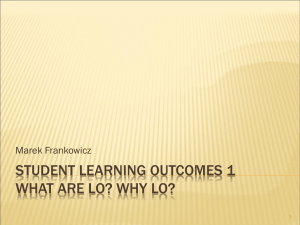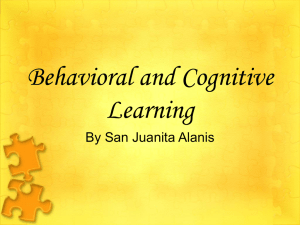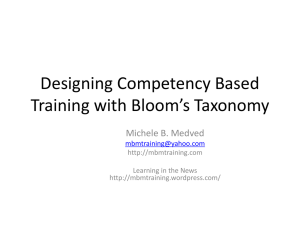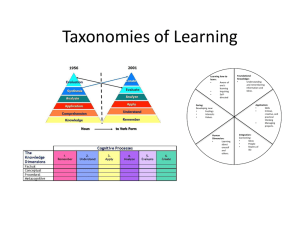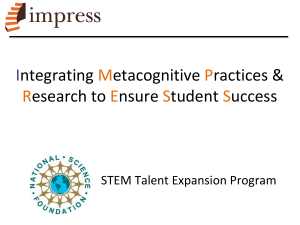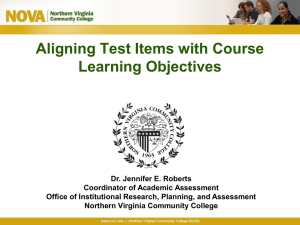Bloom`s Taxonomy of Educational Objectives
advertisement
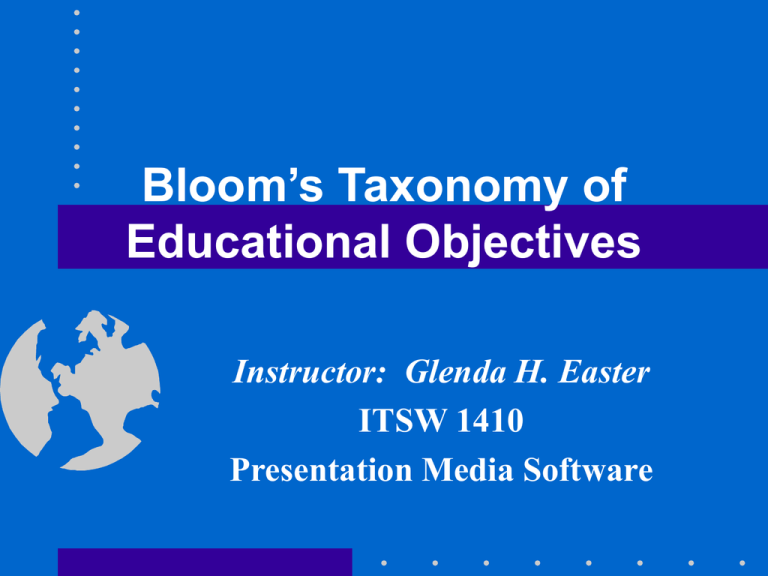
Bloom’s Taxonomy of Educational Objectives Instructor: Glenda H. Easter ITSW 1410 Presentation Media Software Writing Objectives and Assessments • In writing objectives and assessments, it is important to consider different levels of understanding. – For example, in teaching a lesson on topic sentences in reading, you might have students first repeat a definition of “topic sentence,” then identify the topic sentences in paragraphs, and finally write their own sentences for original paragraphs. Bloom's Taxonomy 2 Writing Objectives and Assessments (Continued) – Each of these activities demonstrates a different kind of understanding of the concept “topic sentence,” and we could not consider this concept adequately taught if students could do only one of these activities. Bloom's Taxonomy 3 Background on Bloom’s Taxonomy • In 1956 Benjamin Bloom and some fellow researchers published a taxonomy of educational objectives that has been extremely influential in the research and practice of education ever since. Bloom's Taxonomy 4 Background on Bloom’s Taxonomy (Continued) • A taxonomy is a system of classification. Bloom and his colleagues categorized objectives from simple to complex, or from factual to conceptual. • These key elements are commonly known as Bloom’s taxonomy. Bloom's Taxonomy 5 The Key Elements of Bloom’s Taxonomy • Knowledge (recalling information): – This is the lowest level of objectives in Bloom’s hierarchy, knowledge refers to such objectives as memorizing math facts or formulas, scientific principles, or verb conjugations. Bloom's Taxonomy 6 The Key Elements of Bloom’s Taxonomy (Continued) • Comprehension (translating, interpreting, or extrapolating information): – Comprehension is showing that you have an understanding of the information, as well as the ability to use it. – Examples are interpreting the meaning of a diagram, graph, or parable, inferring the principle underlying a science experience, and predicting what might happen next in a story. Bloom's Taxonomy 7 The Key Elements of Bloom’s Taxonomy (Continued) • Application (using principles or abstractions to solve novel or real-life problems): – Application objectives require students to use or apply the knowledge or principles to solve practical problems. Bloom's Taxonomy 8 The Key Elements of Bloom’s Taxonomy (Continued) • Application (using principles or abstractions to solve novel or real-life problems): (Continued) – Examples include using geometric principles and knowledge to figure out how many gallons of water to put into a swimming pool of given dimensions, and using knowledge of the relationship between temperature and pressure to explain why a balloon is larger on a hot day than on a cold day. Bloom's Taxonomy 9 The Key Elements of Bloom’s Taxonomy (Continued) • Analysis (breaking down complex information or ideas into simpler parts to understand how the parts relate or are organized): – Analysis objectives involve having students see the underlying structure of complex information or ideas. Bloom's Taxonomy 10 The Key Elements of Bloom’s Taxonomy (Continued) • Analysis (Continued): – Analysis objectives might be contrasting schooling in Western societies with informal education in primitive societies, understanding how the functions of the carburetor and distributor are related in an automobile engine, or identifying the main idea of a short story. Bloom's Taxonomy 11 The Key Elements of Bloom’s Taxonomy (Continued) • Synthesis (creation of something that did not exist before): – Synthesis objectives involve using skills to create completely new products. This is the creation of a new idea or higher learning. Bloom's Taxonomy 12 The Key Elements of Bloom’s Taxonomy (Continued) • Synthesis (Continued): – Examples would include writing a composition, deriving a mathematical rule, designing a science experience to solve a problem, and making up a new sentence in a foreign language. Bloom's Taxonomy 13 The Key Elements of Bloom’s Taxonomy (Continued) • Evaluation (judging something against a given standard): – Determining pros and cons about a particular subject. – Evaluation objectives require making a value judgments against some criterion or standard. – For example, students might be asked to compare the strengths and weaknesses of two home computers in terms of flexibility, power and available software. Bloom's Taxonomy 14
